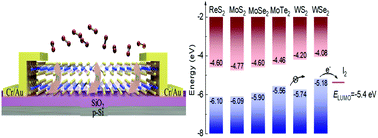Highly selective carrier-type modulation of tungsten selenide transistors using iodine vapor†
Abstract
Despite many decades of substantial research on doping technologies, which are critical for 2D materials used in optical and electrical devices, efforts on selective doping of 2D materials are still scarce. Here, a novel band matching doping strategy is introduced in highly selective doping of WSe2. The key to its realization is the use of dopants whose molecular orbitals closely match the band structure of the 2D materials to be doped. By gradually adjusting the exposure time in iodine vapor, the carrier polarity of the WSe2 FET from the n-type to the p-type can be reversely controlled, whereas the carrier type of ReS2, MoS2, MoSe2, MoTe2, and WS2 remains unchanged. The iodine vapor treatment is also utilized in the manufacturing process flow of high-performance p–n homojunctions with a near-unity ideality factor of 1.002 along with a current rectification of ∼104 and a complementary inverter on a single WSe2 nanosheet. Moreover, selective doping allows the WSe2/ReS2 diode to change from n–n to p–n type for the first time and greatly enhances its photodetection capability. This work presents important progress in selective modulation of the electrical properties of a certain material in an integrated multiple 2D material array.



 Please wait while we load your content...
Please wait while we load your content...